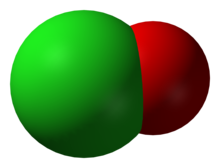Hypochlorite
This article needs additional citations for verification. (February 2009) |

| |
| Names | |
|---|---|
| IUPAC name
Hypochlorite
| |
| Identifiers | |
3D model (JSmol)
|
|
| ChEBI | |
| ChemSpider | |
| ECHA InfoCard | 100.235.795 |
| 682 | |
PubChem CID
|
|
| UN number | 3212 |
CompTox Dashboard (EPA)
|
|
| |
| |
Except where otherwise noted, data are given for materials in their standard state (at 25 °C [77 °F], 100 kPa).
| |
The hypochlorite ion, also known as chlorate(I) anion is ClO−. A hypochlorite compound is a chemical compound containing this group, with chlorine in oxidation state +1.
Hypochlorites are the salts of hypochlorous acid. Common examples include sodium hypochlorite (chlorine bleach or bleaching agent) and calcium hypochlorite (bleaching powder or swimming pool chlorination compound). Hypochlorites are frequently quite unstable — for example, sodium hypochlorite is not available as a solid, since removal of the water from NaClO solution converts it to a mixture of sodium chloride and sodium chlorate. Heating of NaClO solution also causes this reaction. Hypochlorites decompose in sunlight, giving chlorides and oxygen.
Due to their low stability, hypochlorites are very strong oxidizing agents. They react with many organic and inorganic compounds. Reaction with organic compounds is very exothermic and may cause ignition, so hypochlorites should be handled with care. They can oxidize manganese compounds, converting them to permanganates.
Covalent hypochlorites, such as methyl hypochlorite are also known, and are typically unstable.
Preparation
The sodium salt of the hypochlorite ion, NaClO, is formed by the disproportionation of chlorine gas bubbled through dilute aqueous sodium hydroxide at room temperature:
- Cl
2 (g) + 2 NaOH (aq) → NaCl (aq) + NaClO (aq) + H
2O (l)
The reaction of chlorine with hot, concentrated sodium hydroxide forms chlorates of a higher oxidation state:
- 3 Cl
2 (g) + 6 NaOH (aq) → 5 NaCl(aq) + NaClO
3 (aq) + 3 H
2O (l)
Chemistry
Acid reaction
Hypochlorites generate chlorine gas when mixed with dilute acids. Hypochlorite and chloride are in equilibrium with chlorine gas:
- 2 H+
(aq) + OCl−
(aq) + Cl−
(aq) ⇌ Cl
2 (g) + H
2O (l)
Therefore, by Le Chatelier's principle, a high pH drives the reaction to the left by consuming H+
ions, promoting the disproportionation of chlorine into chloride and hypochlorite, whereas a low pH drives the reaction to the right, promoting the release of chlorine gas.
Bleaching action
Hypochlorites are used as bleaches to remove dyes.[citation needed]
As an oxidising agent
Hypochlorite is the strongest oxidising agent of the generalized chlorates;[citation needed]. For example, it oxidises Mn2+
to permanganate:
- 2 Mn2+
+ 5 ClO−
+ 6 OH−
→ 2 MnO−
4 + 3 H
2O + 5 Cl−
Stability
Hypochlorite is the least stable of the chlorine oxyanions[citation needed]. Many hypochlorite compounds exist only in solution, as is also the case with hypochlorous acid (HClO) itself.
Hypochlorite is unstable with respect to disproportionation. Upon heating, it degrades to a mixture of chloride, oxygen and other chlorates:
- 2 OCl−
(aq) → 2 Cl−
(aq) + O
2 (g)
- 3 OCl−
(aq) → 2 Cl−
(aq) + ClO−
3 (aq)
See also
